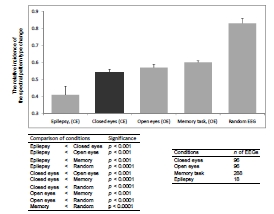Fig. (11).

The relative incidence of the SP type change during the transition between neighboring EEG epochs of the same EEG during different conditions. The data is averaged across all EEGs per condition and presented as a mean ± standard deviation and sorted from smaller values towards larger. Types of individual EEG short-term SPs were determined with the help of a probability-classification analysis [5, 82]. In order to reveal any statistically significant differences between certain conditions, the Wilcoxon test was applied. Statistical significance was assumed where P<0.05.
‘CE’ = closed eyes; ‘OE’ = open eyes; ‘Epilepsy’ = medication-free interictal EEG without epileptiform abnormalities during generalized epilepsy in resting conditions; ‘Random EEG’ = surrogate data: each channel of the actual EEG was subjected to a randomized mixing of SPs. In such a way, the natural dynamics of the SP sequence within each EEG channel was completely destroyed, but the percentage ratio between different types of SPs remained the same. Dark bar represents functional reference baseline - spontaneous EEG during resting state with closed eyes.
